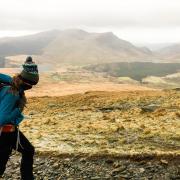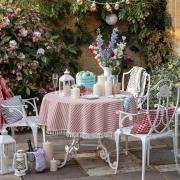From finding a group to nailing your day pack, here’s where to start. By Abi Jackson.
Ever scrolled through photos of people enjoying hikes in the great outdoors, wishing it could be you?
Remember, the outdoorsy influencers posting their adventures were all once beginners too. We asked three of our favourites to share some top tips for newbies…

Finding community
Alice Keegan founded The Adventure Girls Club (www.theadventuregirls.club) to help inspire more women to get outdoors. As well as running day hikes, weekend trips, skills workshops and more, it’s about finding community, which can be a great way into exploring new activities.
“There are so many groups out there,” says Keegan. “Social media is a good place to start, as well as Eventbrite and Meetup.com. Find a group to suit your needs – some groups are for people who want to do more challenging walks, others take it nice and slow. If you feel more comfortable being in a group with the same gender, race or religion to you, there are plenty of amazing groups that represent different communities too.
“I run The Adventure Girls Club – a hiking group for women and non-binary people. I know it can be super scary to show up to these events for the first time, but most people who enjoy the outdoors are nice and welcoming. You all have something in common, so there should be things to talk about, and if you are shy and want to just walk alongside the group and listen to the conversations, that’s fine too!”
Start small with solo hikes
If you’re tempted to hit the trails by yourself, Keegan’s main advice is: “Start small and work your way up. Just go for a small walk from your front door on your own and get used to what it’s like walking by yourself. Then you can build up the confidence gradually to do longer, more remote walks.
“I’d always recommend sharing your route with someone before you leave, with a rough time of return, as well as reading up on how to get help if you needed it,” she adds. “Pack plenty of food, water and layers and always take a first aid kit.
“If you struggle with navigation, download an app such as the OS maps app or book yourself onto a navigation skills course. But mainly, just go for it! Once you start, you will soon learn things and become a better hiker each time you go out.”

Pack smart
“Over-packing can be as problematic as under-packing, but for a host of different reasons,” says Kate Appleby, an adaptive adventurer, advocate and speaker who documents her outdoor adventures whilst living with incurable illness on her Instagram (@kate.s.appleby).
“One way to make sure you nail the perfectly prepared kit bag is to take time to find the bag contents and set-up that really work for you, and pack the night before.
“Don’t rely on just stuffing things in last minute, instead pack sensibly and carefully. Your back will thank you for saving unnecessary weight, while carrying the essentials you need for most eventualities maximises your chances of keeping safe. Think space-saving too. Wrapping some gaffer tape around your hiking poles is a great way of carrying around some emergency repair material, but taking up no added space!”
There’s tons of helpful info on packing online. Key things to think about include: how much food and water will you need? Essential first aid? Navigation tools? Phone charge? Hat/sunnies/SPF? Layers/a waterproof for if the weather turns? Torch? Will you need hygiene supplies?
Be savvy with fuelling
Appleby adds: “When we talk about fuelling our bodies for hiking, it’s easy to concentrate on what we eat and drink the day of a hike – but we should be putting focus on what we consume the day before a hike too. Stay hydrated, avoid alcohol and surgery foods, and consider complex carbohydrates like wholegrain pasta and beans the night before, as a slower-to-digest fuel source.”

Safety first
The goal is to have a lovely day in nature – and chances are, this is what you’ll get. But being prepared in case you do encounter slip-ups is always a good idea.
“In Mountain Rescue, we always say to be ‘Adventure Smart’,” says Carys Rees, who shares content inspiring women to get outdoors via her website (thisgirlwalks.co.uk) and Instagram (@this.girlwalks), as well as being a member of Central Beacons Mountain Rescue. “Do you have the right gear for the day, do you know what the weather will be like, and are you confident in the knowledge and skills you have for the day you have planned?
“Most rescues tend to happen towards the end of the day when people are tired, so a key thing I would always tell people is to make sure your phone is charged and to bring a power bank.
“I also carry a Garmin InReach Mini, a company satellite communicator which essentially allows me to contact people regardless of signal, and also has its own built-in SOS function,” Rees adds. “Knowing what to do in case you do get into trouble is half the battle. So should the worst happen when you are out, dial 999 or 112, ask for ‘Police’ then ‘Mountain Rescue’.”
5 summer hiking best buys

Hydro Flask Trail Lightweight Wide Mouth (946ml), £50, Ellis Brigham
Pricier than basic bottles, but Hydro Flasks are a quality investment that’ll become a trusty favourite for years. Made with pro-grade stainless steel, they’re BPA and phthalate-free and will keep drinks cold for 24 hours or hot for up to 12 hours. Smaller sizes and different colours are also available.

Darn Tough Vermont Women’s Sunset Ledge Micro Crew Lightweight Hiking Sock, £27
Never underestimate the difference a good sock makes – and these are up there with the best. Made with super-soft, breathable merino wool, they feature extra cushioning and targeted protection along the ankle and Achilles, for added comfort and help keep blisters at bay. Plus, the designs are gorgeous.

Osprey Downburst™ Women’s 24 L Backpack, £275
If you’re looking to invest, Osprey backpacks are next level when it comes to fit, comfort and designs that will stand the test of time. Made with recycled nylon, this one has a waterproof main compartment, highly breathable AirSpeed™ suspension for comfort on sweaty trails, endless handy pockets and an external hydration reservoir and port.

AKU Trekker Lite III GTX Women’s Walking Boots, £200
What stands out about these is how comfortable and well-fitting they feel from the off (we didn’t even need to break them in), and they look great with four stylish colourways available. Sturdy yet lightweight, with Gore-Tex® lining and suede uppers, a truly great buy.

On Women’s Trek Pants, £120
Ideal if you prefer something looser than a legging, but still with some stretch for comfort, these lightweight trek pants – made with mainly recycled materials – feature an adjustable belt and three pockets (one with concealed zip). Available in black or safari.


























